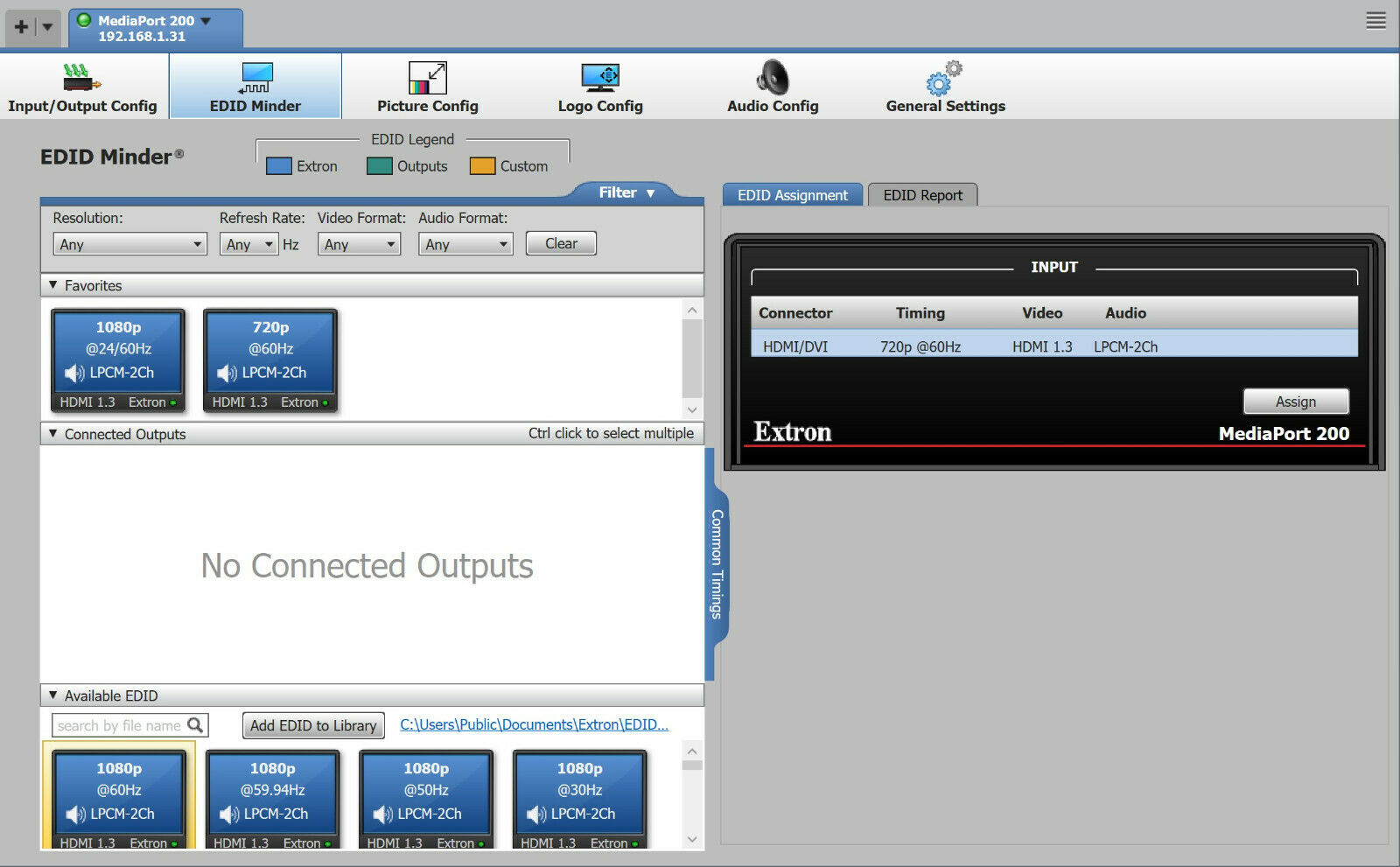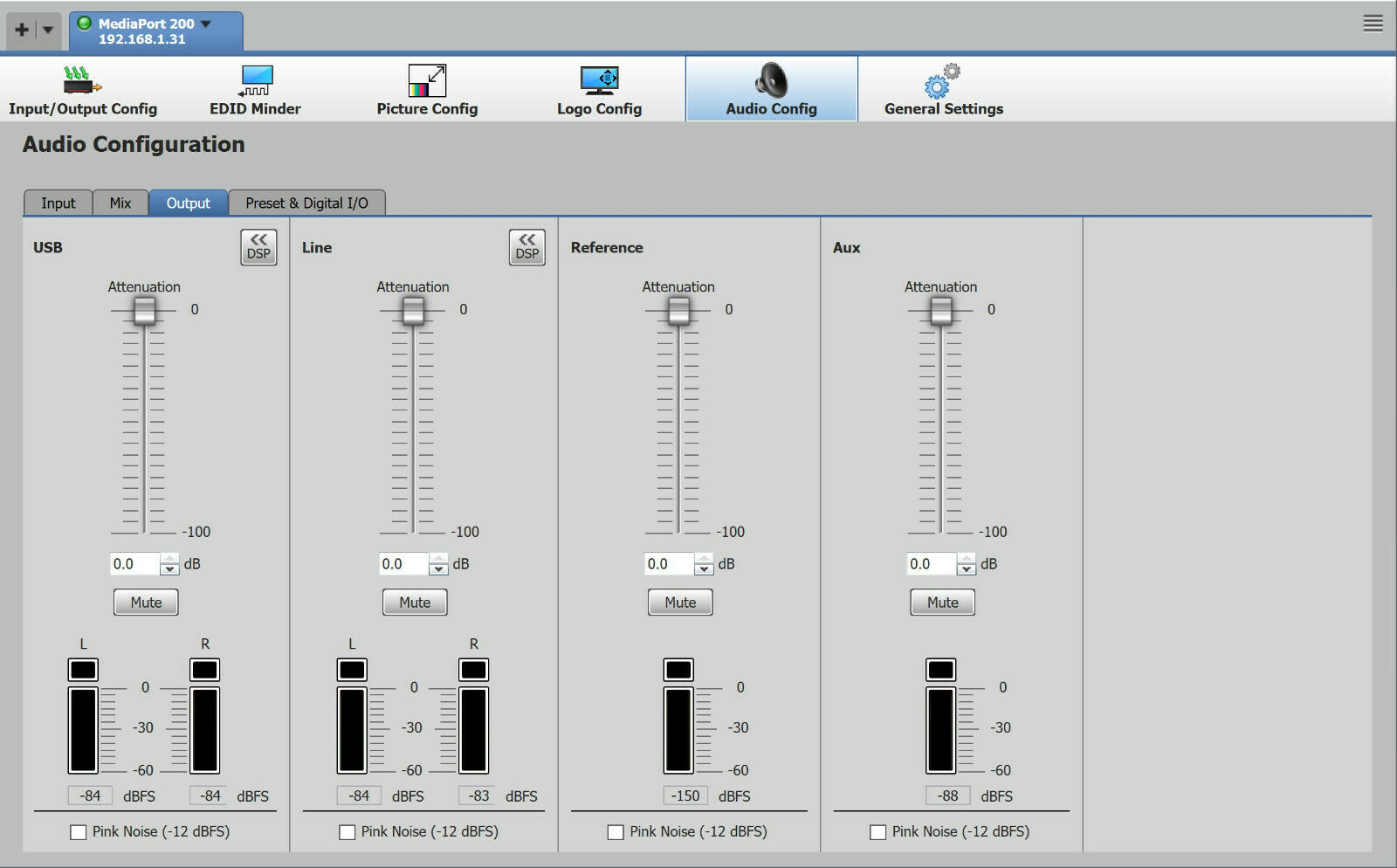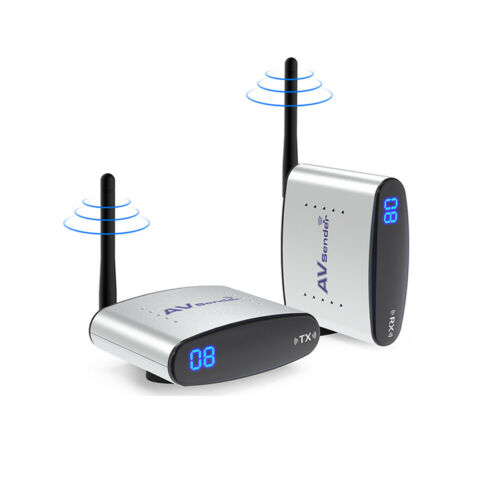-40%
Extron Electronics MediaPort 200 HDMI and Audio to USB Scaling Bridge - USED
$ 258.18
- Description
- Size Guide
Description
Used unit removed from Corp Environment - Excellent condition. Includes all rear connectors.Great for Streaming!
Upgraded to the current 1.07 Firmware.
The Extron
MediaPort 200
is an HDMI to USB bridge for integrating pro AV sources or systems with software codec conferencing applications. It works seamlessly with a computer using generic USB video and audio drivers. The MediaPort
®
features an HDMI input with HDCP-compliant loop through, accepts signals up to 1920x1200, and scales video to a USB 2.0 output. Audio features include program and mic inputs, HDMI audio de‑embedding, and USB bidirectional audio, plus AEC reference and line level outputs. The MediaPort 200 also includes DSP with EQ, filters, mixing, dynamics, and ducking. This allows the MediaPort 200 to serve as a complete soft codec interface, with the added flexibility of integrating into larger hardware codec or DSP systems. The MediaPort 200 enables versatile integration of conferencing computers into pro AV designs.
Optimal Video Processing for Soft Codecs
The MediaPort 200 accepts resolutions up to 1080p/60 and 1920x1200, and provides high performance deinterlacing of interlaced signals up to 1080i. To ensure the HDMI source is presented with the highest possible image quality to a soft codec, the MediaPort 200 incorporates video processing technology, specifically engineered for optimized image scaling and frame rate conversion that preserves detail and legibility of source content. Output resolutions range from 320x180 to 1080p/15, and are dynamically configured by the software codec as it responds to real-time CPU usage and bandwidth conditions between near-end and far-end locations. The video output is delivered as an MJPEG-encoded stream over USB 2.0.
The MediaPort 200 is a fully featured video processor with many of the core integration features common to Extron scalers, including aspect ratio control, internal test patterns, Auto-Image™, and Auto Input Memory. It can also display a user-supplied logo image whenever no signal is present at the HDMI input.
Seamlessly integrates pro AV sources or systems into software codec applications
— Sends audio and video signals from a presentation source or switcher to a computer, for integration with software and cloud-based communication platforms.
Inputs: One HDMI with buffered loop-through, one stereo balanced/unbalanced audio input on captive screw, one mic or line balanced/unbalanced audio input on captive screw, one USB 2.0 for four-channel audio input – stereo playback and stereo communications
Outputs: One USB 2.0 for streaming video and two-channel audio output, one stereo balanced/unbalanced audio output on captive screw, balanced/unbalanced mono AEC reference and auxiliary audio mono outputs on captive screw
USB 2.0 device connection uses generic USB drivers for universal compatibility
— The MediaPort 200 incorporates industry standard UVC - USB Video Class and UAC - USB Audio Class drivers, providing universal compatibility with Windows
®
, Mac OS
®
, Linux, and other operating systems.
Video scaling provides USB output from 320x180 to 1080p/15 to match common software codec requirements
— Ensures optimal quality of camera or computer video content for far-end conferencing participants.
Scaling optimized to UC software codec requirements via custom resolution groups
— User-customizable resolutions can be defined in groups such as high, medium, and low quality to force the software codec to use the best scaled USB streaming resolution for current network and codec processor conditions.
Scaled USB streaming video output with MJPEG encoding
Integrated audio DSP
— Provides audio mixing and signal processing capabilities, including mixing and routing for 4x2 audio. The DSP is optimized for integration with mic and program audio sources as well as software codecs, hardware codecs, external DSP, and sound reinforcement.
AEC reference output
— This output provides far-end audio to an external AEC-equipped DSP. This audio is used by the external DSP as a reference signal for AEC - acoustic echo cancellation processing, to ensure echo-free conferencing for far-end participants.
HDCP-compliant HDMI input and loop-through
— Provides an output signal for a local display, an AV system, or a hardware codec, enabling the content to be monitored or shared without the need for a separate distribution amplifier. Both the HDMI input and loop-through are HDCP-compliant.
HDMI audio de‑embedding
— Embedded HDMI two‑channel PCM audio can be extracted to the integrated DSP for processing and mixing.
USB 4x2 audio interface
— The USB connection provides a 4x2 channel audio interface with a computer, similar to a standard USB sound card with send and return audio capability. This allows the MediaPort 200 to send a two-channel audio source mix to the personal computer, and the computer to deliver its program audio plus two-channel communication audio from the soft codec’s far-end to the MediaPort 200.
Supports popular software communications platforms including Microsoft
®
Skype
®
/Skype
®
for Business/Teams, Adobe
®
Connect™, Apple FaceTime, BlueJeans, Cisco
®
WebEx
®
, Citrix
®
GoToMeeting™, Google Hangouts, Lifesize
®
Clearsea, and Zoom
Compatible with virtual computing environments using thin/zero client systems such as Citrix XenApp® and VMWare Horizon®
— Includes USB support for systems running low bandwidth clients.
Accepts HDMI computer and video resolutions up to 1080p/60 and 1920x1200
High performance deinterlacing for signals up to 1080i
— Features highly accurate deinterlacing for 480i/576i/1080i signals. This ensures absolute detail and fidelity in the reconstructed progressive video frames, including 3:2 and 2:2 pulldown for interlaced signals originating from film content.
Mic/line input with 48 volt phantom power
— A mic or line level audio source can be mixed with program audio. Selectable 48 volt phantom power allows the use of condenser microphones.
Front panel LED indicators for HDMI and USB signal status
— Provide visual feedback for HDMI input and loop-through signal presence, HDCP status, plus USB signal presence for the host computer, video send, audio send, and audio return.
Logo image display
— The MediaPort 200 can be set to automatically display a user-supplied image file on the HDMI output whenever no signal is present or on the USB output if HDCP-protected content is being used and no video can be displayed.
Aspect ratio control
— The aspect ratio of the video output can be controlled by selecting a FILL mode, which provides a full screen output, or a FOLLOW mode, which preserves the original aspect ratio of the input signal.
Auto Input Memory
— When activated, the unit automatically stores size, position, and picture settings based on the incoming signal. When the same signal is detected again, these image settings are automatically recalled from memory.
Internal video test patterns and pink noise generator for calibration and setup
— The MediaPort 200 offers several video test patterns to facilitate proper system setup and calibration, and can provide an active output when an input video source is not available. The pink noise generator is selectable for all audio outputs, including USB audio to the computer, and aids in optimizing audio output signals.
Pictures controls for brightness, contrast, horizontal and vertical positioning, and sizing
User-selectable HDCP authorization
— Allows the unit to appear HDCP compliant or non-HDCP compliant to the connected source, which is beneficial if the source automatically encrypts all content when connected to an HDCP-compliant device. Protected material is not passed in non-HDCP mode.
HDCP Visual Confirmation
— When HDCP-encrypted content is transmitted to a non-HDCP compliant display, or to the USB output, a full screen green signal is sent to the display for immediate visual confirmation that protected content cannot be viewed on that display. An optional logo can be sent to the USB output in place of the green signal if desired.
EDID Minder
®
automatically manages EDID communication between connected devices
— EDID Minder ensures that the source powers up properly and reliably outputs content for display.
Auto-Image™ setup
— When activated, the unit automatically optimizes the image by analyzing and adjusting to the video input signal. This can save time and effort in setting up a newly connected source, particularly in presentation environments where different guest presenter laptops with various output resolutions will be connected.
User image presets
— 16 memory presets are available to store and recall optimized image settings.
Parametric EQ, filters, and compression on all inputs
— Equalization and filters are available to fine-tune acoustic characteristics of microphones and program sources. Compression helps to compensate for source signals with widely varying or unpredictable signal levels.
Parametric EQ, filters, and limiter on USB and line outputs
— The MediaPort 200 provides nine-band equalization for room tuning. It also detects actual onset of clipping by comparing input and output waveforms. Gain is automatically reduced without audible artifacts to protect the audio system from clipping distortion.
Microphone and USB audio ducking
— Automatically lowers program audio volume when a microphone or far-end USB audio signal is detected, eliminating the need for a separate audio ducking processor.
24-bit/48 kHz analog-to-digital and digital-to-analog audio converters
— High performance converters preserve audio signal integrity for input and output signal conversion.
Fixed, low latency DSP audio processing
— Input to output latency is fixed within the MediaPort 200, regardless of the number of active channels or processes, maintaining audio and video synchronization.
User-definable DSP audio presets allow quick recall of commonly used configurations
— Up to 16 user presets can be created using the Extron PCS software application. Once created, presets can easily be recalled from the PCS software or a control system.
Mute and gain audio group masters
— The MediaPort 200 provides pre-configured group masters for consolidated mute and gain, simplifying real-time system control.
Soft limits provide optimal master volume adjustment range
— When using external volume control, the master volume range can be regulated with soft limits to maintain optimal minimum and maximum levels. This prevents operators working with digital I/O, RS‑232, or Ethernet control from exceeding pre-defined limits.
Live DSP configuration
— Allows live parameter adjustments while previewing or metering them in real-time. This avoids the need to compile and upload a configuration file to the device.
Front panel controls with LCD display
— Allows convenient access to configuration and status of the MediaPort 200.
Front panel USB configuration port
— Enables easy configuration without having to access the rear panel.
Two digital input and two digital output control ports
— Allow external triggering such as mic activation and muting, as well as illuminating mic status LEDs. Digital inputs can also be used for recalling DSP presets and adjusting volume via contact closure.
+12 VDC, 100 mA remote power
— Provides remote power for various applications, such as LED illumination for mic status and mute.
Front panel security lockout
— Locks out all front panel functions; all functions however, are available through Ethernet, USB, and RS‑232 control.
Ethernet monitoring and control
— Enables control and proactive monitoring over a LAN, WAN, or the Internet.
RS‑232 control port
— Enables the use of serial commands for integration into a control system. Extron products use the SIS™ - Simple Instruction Set command protocol, a set of basic ASCII commands that allow for quick and easy programming.
Built‑in webpages
— Enables the use of a standard browser for monitoring or updates over an intuitive Web interface.
Easy setup and commissioning with Extron's PCS - Product Configuration Software
— Conveniently configure multiple products using a single software application. The software also allows configuration files to be downloaded for archiving or configuring multiple systems.
Compact 1U, half rack width metal enclosure
— The half rack width enclosure is designed for flexible mounting using a wide variety of Extron furniture and rack mounting kits, available separately. Passive convection cooling ensures silent operation.
(LOCATION B2)



















